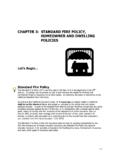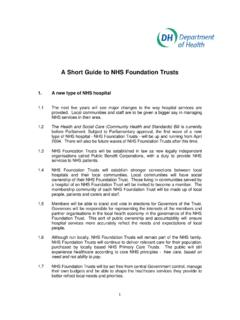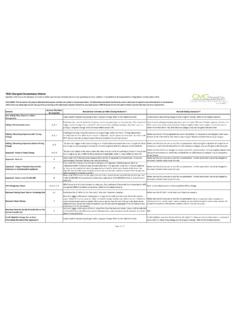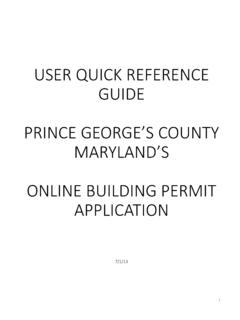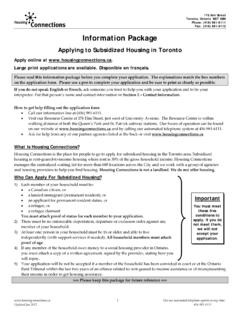Transcription of CHAPTER 10: Business Owner Policy (BOP) - Mike …
1 CHAPTER 8: Business Owner Policy Let s businessowners Policy (BOP) provides a broad package of coverages for small and medium-sized apartment buildings, offices, and retail stores. Each Policy includes mandatory property and liability coverages, and offers optional coverages. Many standard conditions and exclusions apply. A BOP is a self-contained, complete package forms are modeled after the coverage components of the commercial package Policy program, and have similar exclusions and coverages A, B, and C of the CGL Policy . The same wording, organization of coverages, and design follow the CPP. Businessowners coverage parts are attached to the Policy declarations and a businessowners common conditions form. ISO has made recent changes in the BOP program as of types of risks which are eligible for a BOP include: apartment buildings which do not exceed six stories in height and do not have more than 60 dwelling units (incidental mercantile, service or processing risks which do not exceed 15,000 square feet, and incidental offices are permitted); office buildings which do not exceed six stories in height and do not exceed 100,000 square feet in total area (incidental mercantile, service or processing risks which do not exceed 15,000 square feet, and apartments within the office building are permitted);8-1 mercantile risks which do not exceed 25,000 square feet and do not have annual gross sales in excess of $3 million.
2 Service or processing risks which do not exceed 25,000 square feet and do not have annual gross sales in excess of $3 million, provided that no more than 25 percent of their gross sales is derived from off -premises operations; and building owners and Business operators who are tenants are eligible. Residential condominium associations and office condominium associations are eligible. Service and processing risks are newly eligible for coverage (previously, mercantile risks involving retail sales of merchandise were eligible, but risks involving service or processing were not eligible). Motels Self-storage facilities Contractors Fast food and limited-cooking restaurants up to 7,500 square feet Convenience stores with gasoline sales of up to 75% of the total revenue Dry cleaners that clean on premises The businessowners program is designed to provide coverage for a variety of landlords and Business operators who have moderate insurance exposures.
3 For this reason, eligibility is defined to exclude certain risks which do not fit the intended exposure Risks for BOPThe following risks are ineligible for coverage under the program: automobile dealers and all types of automotive repair and service operations, banks and all types of financial institutions, places of amusement, and types of risks all have special insurance exposures, and must be insured outside of the businessowners Components of a Businessowners PolicyEach BOP is a complete contract and must include the following parts: the Businessowners Policy declarations, the Businessowners Policy Coverage form (ISO BP 00 03 07 02) endorsements as Declarations The Policy declarations will show the Policy number, name of the insurance company, name of producer, name and address of the named insured, and the Policy period. Spaces are provided for a description of the Business , the form of Business , locations of described premises, and name and address of any mortgage of insurance will be shown for buildings and for Business personal property.
4 Limits of insurance for optional coverages will be shown, and optional coverages will apply, only if the appropriate boxes are checked indicating that optional coverages Coverage Form- Section IStandard vs. SpecialProperty coverage must be written on either the standard or the special property coverage form. The two forms may not be combined. Most coverages provided by the two forms are identical. The major differences are in the covered causes of loss standard coverage is similar to basic coverage provided by other commercial forms, while special coverage means the same open perils type coverage provided by the special causes of loss form. There are minor differences in the optional coverages available with each , the major property coverages are the same and businessowners property coverage can be discussed as a single topic. Both businessowners forms provide the following two major coverages: Coverage A Building(s), and Coverage B Business Personal limit of insurance must be shown in the declarations for each type of property covered.
5 For example, an insured Business that is a tenant would not require the building A BuildingsBuilding coverage means the buildings and structures described in the declarations. The coverage also applies to completed additions; fixtures, machinery and equipment which are permanently installed; the insured s personal property in apartments or rooms furnished by the insured as landlord; outdoor fixtures; and the insured s personal property used for service or 8-3 maintenance of the building or its premises (such as fire extinguishers, outdoor furniture, floor coverings and appliances used for refrigerating, ventilating, cooking, dishwashing or laundering).If not covered by other insurance, building coverage also includes additions under construction, building alterations and repairs, and materials, equipment, supplies and temporary structures on or within 100 feet of the premises used for making additions, alterations or repairs to the buildings or B Business Personal PropertyCoverage for Business personal property has traditionally been known as contents coverage.
6 But it includes more than building contents because it applies to property of the named insured located in or on the described building, or within 100 feet of the described premises while in a vehicle or out in the property includes property owned by the insured and used in the insured s Business ; property of others in the insured s care, custody or control; and your interest as a tenant in improvements and betterments made at the insured s own expense but which cannot be legally removed. Coverage for the property of others is limited to the amount for which the insured is legally liable, plus the cost of labor, materials or services furnished by the CoveragesIn addition to the coverage for direct loss to insured property by covered causes of loss, a BOP provides a number of additional coverages. The standard Policy form has six additional coverages, and the special form adds two more for a total of eight.
7 The additional coverages are: debris removal expenses, loss to property while removed from the premises to preserve it from loss, fire department service charges, Business income, extra expense, pollutant cleanup and removal, collapse (special form only), and damage by water or other substances (special form only).In this CHAPTER , we will only discuss the some of the most important additional coverages in Income If it is necessary to suspend operations because of direct physical loss caused by a covered cause of loss, the insurance company will pay for loss of Business income during a period of restoration. 8-4 It will only pay for loss of Business income that occurs within 12 consecutive months after the date of loss. This additional coverage is not subject to the limits of insurance shown on the Policy . Furthermore, the declaration page shows which causes of loss are Expense The insurance company will also pay extra expenses incurred during a period of restoration for the purpose of avoiding or minimizing a suspension of operations.
8 This coverage also applies only during the 12 consecutive months following a direct loss, and is not subject to the limits of Income from Dependent PropertiesCoverage is provided for the insured s loss due to a loss at another property on which the insured depends to provide either materials or services to run the insured s Business . The coverage is for $5,000, but higher limits are available. There is also a 72-hour waiting period before this coverage begins. Coverage ExtensionsThe businessowners standard and special property forms provide the same four extensions of coverage, which are in addition to the limits of insurance shown on the Policy . The extensions of coverage available are: Personal property at newly acquired premises, Personal property off premises, Outdoor property, Personal effects Valuable papers and records Accounts receivablesThese will be further discussed in the next pages.
9 Personal Property at Newly Acquired PremisesThe insured may extend the coverage for buildings and Business personal property to apply at any premises newly acquired. The most the insurance company will pay under this extension is $250,000 at each building and $100,000 for Business personal property at each premises. Coverage under this extension will end as soon as any of the following occur: the Policy expires, the insured reports actual values to the insurance company, or 30 days expire after the date the premises is acquired or construction begins. An additional premium will be charged from the date of acquisition for the new values Personal Property off Premises The insured may extend the coverage for personal property to apply to covered Business personal property, other than money or securities, while off premises in the course of transit or temporarily at a premises the insured does not own, lease or operate.
10 The most the insurance company will pay for loss or damage under this extension is $1, Property The insured may extend the insurance to apply to outdoor property, such as fences, radio and television antennas, signs which are not attached to buildings, trees, shrubs, plants, including debris removal expense, for losses resulting from the specific perils of (1) fire, (2) lightning, (3) explosion, (4) riot or civil commotion, or (5) aircraft. The most the insurance company will pay for loss under this extension is $2,500, and not more than $500 for any one tree, shrub or EffectsThe insured may extend coverage that applies to Business personal property to also apply to personal effects owned by the insured, officers, partners, or employees. But this extension of coverage does not apply to the peril of theft, or to tools or equipment used in the Business . The maximum amount the insurance company will pay under this extension is $2, Papers and Records The insured may extend the coverage that applies to Business personal property to apply to the costs of researching, replacing or restoring the lost information on valuable papers and records which have suffered loss or damage, including those which exist on electronic or magnetic media for which duplicates do not exist.
